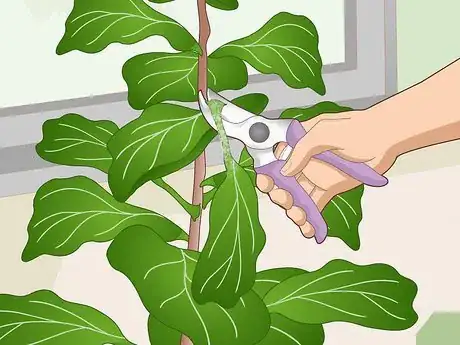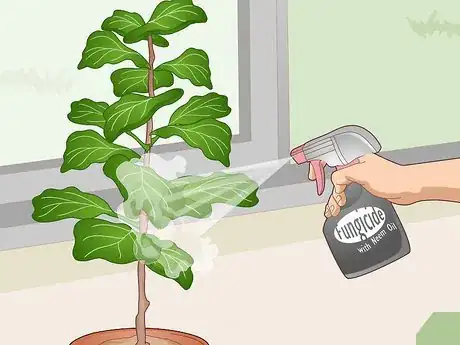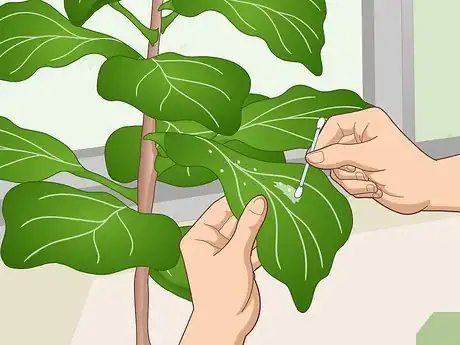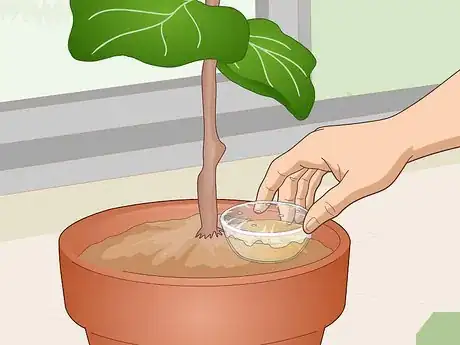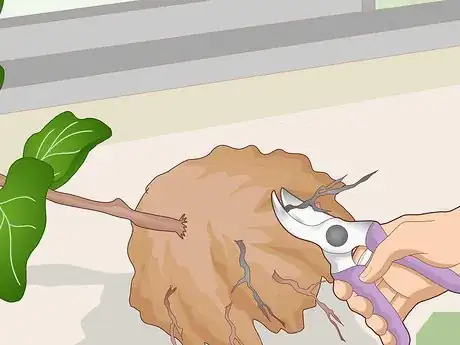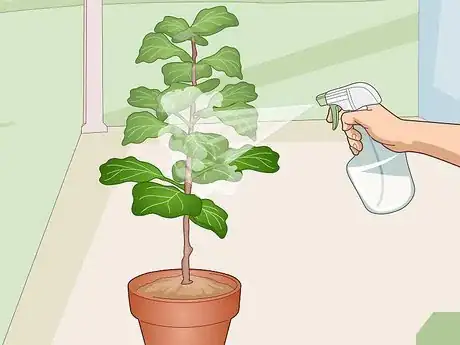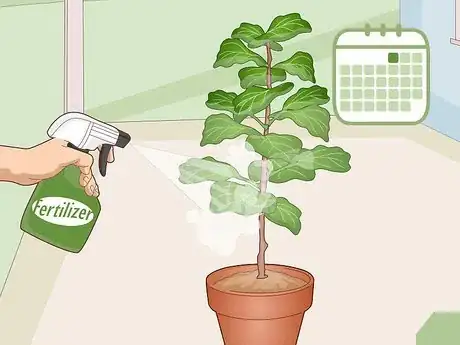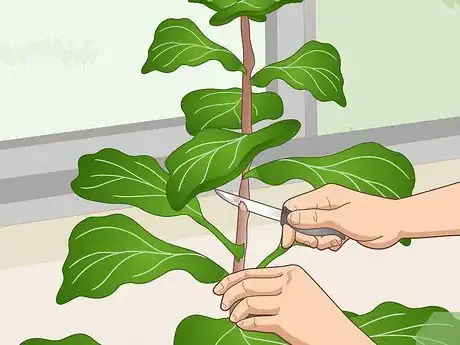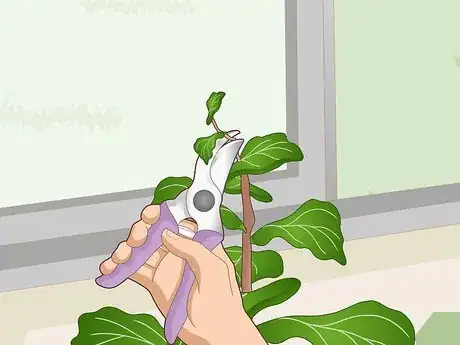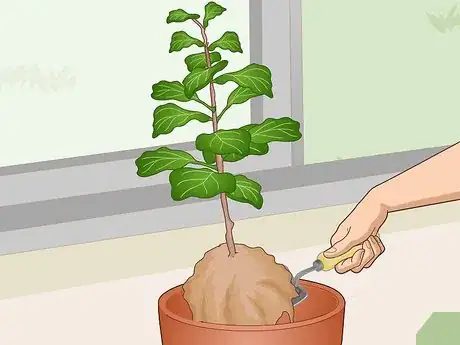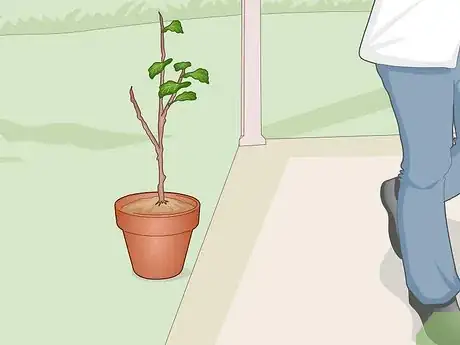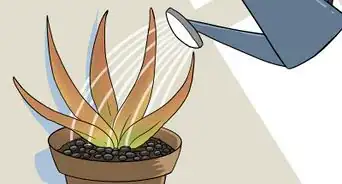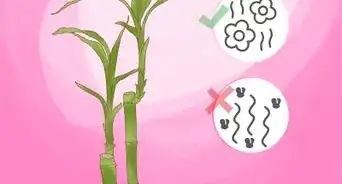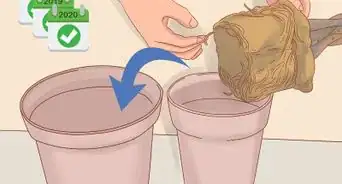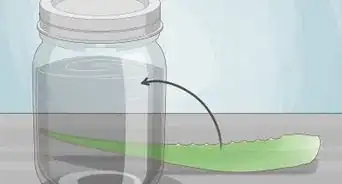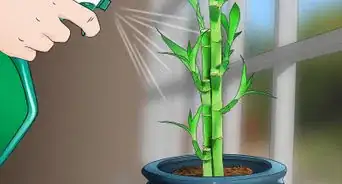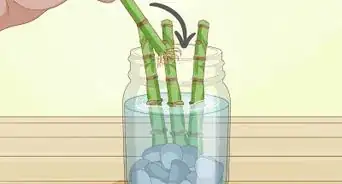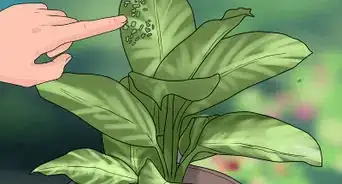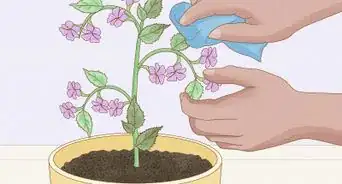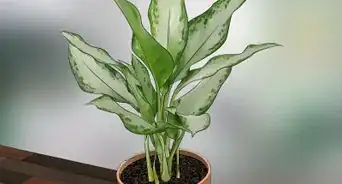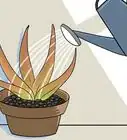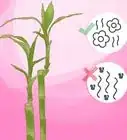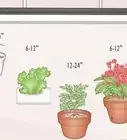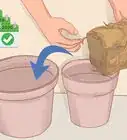This article was co-authored by Ryan Glynn, CPA. Ryan Glynn is a Plant Specialist, Interiorscaper, and the Founder of Chicago Plants, LLC. He specializes in houseplant care, interior plant-scaping, and gardening. Ryan and Chicago Plants have been featured in several media outlets such as TimeOut Magazine and the Chicago Tribune. Ryan holds a BBA and Master’s degree in Accounting from The University of Wisconsin-Madison.
There are 17 references cited in this article, which can be found at the bottom of the page.
This article has been viewed 31,799 times.
Fiddle leaf figs are popular houseplants with large, bright green leaves that brighten almost any space. While fiddle leaf figs are relatively easy to care for, they are prone to developing a few challenging issues. If your fiddle leaf fig is struggling, you can often save it by treating its particular issue and providing the right care and conditions. Once your plant is on the mend, encouraging new growth will revive your plant and help it thrive.
Steps
Treating Common Issues
-
1Remove brown, dead leaves so they don’t drain the plant’s resources. Using your hands or a pair of sharp pruning scissors, pull or cut off all the leaves that are brown, yellow, or shriveled up. Leave the healthiest leaves on the plant to give them a chance to revive.[1]
-
2Prune away moldy-looking branches in the spring. If you notice any white, powdery mildew growing on the stems or branches, use a sharp pair of pruning shears to remove the infected area from the plant.[4] You can prune your fiddle leaf fig any time of year, but pruning in the spring allows the plant to get the light it needs to recover and grow.[5]
- Avoid the temptation to wipe off the mildew since this can actually spread the spores to other areas of the plant.
Advertisement -
3Spray your plant with neem oil if there’s mildew on the main stem. Purchase a plant fungicide spray that is neem oil-based and generously cover the mildewed area with it. Repeat this every few days until the mildew starts to die and clear up.[6]
- You can also use neem oil on leaves that appear healthy otherwise.
- Instead of neem oil, you can mix 1 teaspoon (2.5 grams) of baking soda with 1 US quart (950 mL) of water in a spray bottle. Spray the mildew liberally until with the solution until it clears up.
- Neem oil-based fungicide sprays are widely available online and at plant supply stores.
- Always disinfect your pruning shears with isopropyl alcohol to prevent the potential spread of disease.
-
4Use water, alcohol, and neem oil to kill spider mites and mealy bugs. If you notice small white or black bugs or dark spots on the leaves, branches, or stem, spray the infected areas with water to manually remove as much as you can. Then, dip a cotton swab in alcohol and press it on each spot to kill the bugs.[7]
- The small black bugs or dots are most likely spider mites, while the white spots are usually mealy bugs.
- You may also want to spray your plant with a neem oil-based product to kill any bugs that you can’t see.
-
5Create a gnat trap to get rid of a gnat infestation. If you see any gnats flying around your plant, fill a small dish with honey or apple cider vinegar. Cover the dish with plastic wrap, then use a toothpick to poke a few holes in the top. Place your gnat trap on top of the soil next to your plant.[8]
- The gnats will crawl into the holes to get to the honey or apple cider vinegar, but they likely won’t be able to get back out.
- It can also be helpful to allow your plant’s soil to dry out while you’re treating the infestation. Gnats generally nest in the top layer of soil and thrive in moisture, so letting the soil dry out will keep them from laying and hatching eggs.
- Setting a gnat trap usually gets rid of a gnat infestation within a few weeks.
-
6Transfer your plant to a pot with better drainage if it has rot root. If the leaves are falling off or turning brown around the edges, carefully lift the plant out of its pot to examine the roots for rot. If any of the roots are wet, brown, and mushy, cut them off with pruning shears. Then, plant your fiddle leaf fig in fresh soil and a new pot with better drainage.[9]
- Your fiddle leaf fig may be dying from root rot, even if the soil on top is dry to the touch. The only way to be sure is to lift it out of the pot and examine the roots.
- Use a quick-draining, all-purpose soil in the new pot.[10]
- You can check the drainage by watering your fiddle leaf fig and making sure excess water drips out the drainage holes in the bottom.
-
7Cut off the dead roots to make room for healthy roots to grow. If your fiddle leaf fig appears dry and under-watered, take the plant out of its pot and examine the roots to see if any are brown, shriveled, and straggly. If so, use a sharp knife to cut through the roots to loosen them, then pull them away from the soil and off the plant.[11]
- Brown, shriveled, and straggly roots are probably too dehydrated to be revived. Removing them allows the healthy roots better access to the water and nutrients they need to thrive.
-
8Repot your plant with fresh soil if it has a bacterial infection. If the leaves on your plant are turning brown or yellow, carefully lift your plant out of its current pot. Gently remove as much of the old soil from the root ball as you can to avoid transferring the bacteria into the new soil. Then, replant your fiddle leaf fig in a new pot with good drainage and fresh soil.[12]
- Water your plant as little as possible after repotting until it recovers to keep the bacteria from spreading.
- Keep your repotted fiddle leaf fig in an area with good air circulation to help prevent bacteria from festering and growing.
Providing the Right Care and Conditions
-
1Position your plant so that it gets 6 hours of bright, indirect sunlight daily. Bright, indirect light allows the plant to get the sunlight it needs to revive without getting overheated. If your plant doesn’t get enough sun, the leaves will likely start to brown and fall off.[13]
-
2Keep the room between 60 to 90 °F (16 to 32 °C). Maintaining a moderate to warm room temperature also keep your fiddle leaf fig from overheating or getting too cold.[14] In addition, keep your plant away from drafty areas as much as possible. Even if you control the room temperature, windows, air vents, and heaters can cause the leaves to brown.[15]
- If your fiddle leaf fig gets too cold, you may start seeing red spots on the new leaves. If this occurs, move your plant to a warmer location.[16]
-
3Water your fiddle leaf fig about once per week when the soil feels dry. When your fiddle leaf fig’s soil starts to feel slightly dry to the touch, water it until the soil is moistened. Leave the plant in the sink or outside for a few hours to let the water drain out the bottom so that the roots don’t start to rot.[17]
- While it’s important not to overwater your struggling fiddle leaf fig, it’s equally important that the soil doesn’t completely dry out. Watering your plant about once per week should provide enough water to help revive it without over-moistening the soil.
-
4Fertilize your plant once a month except in the winter. During the spring, summer, and fall, add about 1 teaspoon (4.9 mL) of liquid fertilizer to your fiddle leaf fig’s soil.[18] Avoid adding fertilizer during the winter or more than once per month so you don’t give the plant more nutrients than it’s able to utilize.[19]
- Granular fertilizer can be hard to work with and you may risk over-fertilizing the plant. Using a liquid fertilizer is generally a safer bet because it's easier to control.[20]
- For best results, use a fertilizer that is specifically formulated for fiddle leaf figs. If you can't find that, use an all-purpose fertilizer that contains approximately 30% nitrogen, 10% phosphorous, and 20% potassium.[21]
- If your fiddle leaf fig has any mildew on its branches, avoid fertilizing until the mildew clears up.[22]
Encouraging New Growth
-
1Notch your fiddle leaf trunk to encourage it to grow new branches. First, decide where you want to encourage your fiddle leaf to sprout a new branch. Then, use a sharp knife to make a 1⁄8 inch (0.32 cm) cut on the trunk just above the node closest to your desired branch location.[23]
- If you had to prune a lot of unhealthy branches and leaves, notching is a great way to help revive your fiddle leaf fig by encouraging it to grow new, healthy branches.
- A bit of white, sticky sap may drip out of the notched area.
-
2Cut off the newest growth to make it branch out more. To help revive your fiddle leaf fig and encourage it to grow more branches, try “pinching” your plant by cutting off the newest growth on the top of the tree with pruning shears. As the cut scabs over, it will force the plant to grow outward in multiple new directions from that spot.[24]
- Pinching not only helps revive your fiddle leaf fig, it also allows you a bit of control over the shape your plant will take as it grows.
-
3Transfer your plant to a new pot when you see new growth. If your fiddle leaf fig’s roots start to outgrow its current pot but your plant has been struggling, wait until you see new growth on the plant before repotting it.[25] If you repot your fiddle leaf fig before it starts to revive, it may not be healthy enough to handle being disturbed and moved into a new environment.
-
4Leave bare branches intact in case they re-sprout in the spring. To help encourage your fiddle leaf fig to grow, avoid pruning any brown, bare branches unless they’re covered in mildew. In many cases, fiddle leaf fig branches remain bare as they recover from common issues. Once your plant has had plenty of time to recover, bare branches may sprout new leaves during the spring growing season.[28]
- In addition, if the bare branches have any hard, brown husks, leave these along as well. These husks may be protecting new growths as your plant recovers from its issues.
Things You’ll Need
- Pruning shears
- Neem oil-based spray
- Rubbing alcohol
- Cotton swabs
- Water
- Small dish
- Honey or apple cider vinegar
- Plastic wrap
- Toothpick
- Pot with drainage hole
- All-purpose soil
- Knife
- Liquid fertilizer
References
- ↑ https://youtu.be/ggS6yMhWBlA?t=24
- ↑ https://fiddleleaffigplant.com/how-to-revive-a-dead-fiddle-leaf-fig/
- ↑ https://fiddleleaffigplant.com/prevent-and-treat-bacterial-infections-in-fiddle-leaf-figs/
- ↑ https://fiddleleaffigplant.com/how-to-prevent-and-treat-powdery-mildew-on-a-fiddle-leaf-fig/
- ↑ https://fiddleleaffigplant.com/pruning-and-shaping-your-fiddle-leaf-fig-plant/
- ↑ https://fiddleleaffigplant.com/how-to-prevent-and-treat-powdery-mildew-on-a-fiddle-leaf-fig/
- ↑ https://fiddleleaffigplant.com/the-ultimate-guide-to-fiddle-leaf-fig-insect-problems-video/
- ↑ https://fiddleleaffigplant.com/the-ultimate-guide-to-fiddle-leaf-fig-insect-problems-video/
- ↑ https://blog.leonandgeorge.com/posts/2018/6/25/diagnosing-and-treating-root-rot-in-fiddle-leaf-fig-plants
- ↑ https://www.thegardenglove.com/fiddle-leaf-fig-caring-this-trendy-houseplant/
- ↑ https://youtu.be/ggS6yMhWBlA?t=55
- ↑ https://fiddleleaffigplant.com/prevent-and-treat-bacterial-infections-in-fiddle-leaf-figs/
- ↑ https://fiddleleaffigplant.com/how-much-light-does-a-fiddle-leaf-fig-tree-need/
- ↑ https://www.gardenista.com/posts/7-secrets-how-to-save-a-dying-fiddle-leaf-fig-tree/
- ↑ https://www.thegardenglove.com/fiddle-leaf-fig-caring-this-trendy-houseplant/
- ↑ https://www.katrinaleechambers.com/care-fiddle-leaf-fig/
- ↑ https://www.gardenista.com/posts/7-secrets-how-to-save-a-dying-fiddle-leaf-fig-tree/
- ↑ https://youtu.be/vBfS-fBqQgo?t=127
- ↑ https://www.thegardenglove.com/fiddle-leaf-fig-caring-this-trendy-houseplant/
- ↑ https://youtu.be/vBfS-fBqQgo?t=116
- ↑ https://blog.leonandgeorge.com/posts/2018/4/3/what-is-the-best-fertilizer-for-a-fiddle-leaf-fig-plant
- ↑ https://blog.leonandgeorge.com/posts/2018/6/25/diagnosing-and-treating-root-rot-in-fiddle-leaf-fig-plants
- ↑ https://fiddleleaffigplant.com/how-to-revive-a-dead-fiddle-leaf-fig/
- ↑ https://fiddleleaffigplant.com/how-to-revive-a-dead-fiddle-leaf-fig/
- ↑ https://www.gardenista.com/posts/7-secrets-how-to-save-a-dying-fiddle-leaf-fig-tree/
- ↑ https://youtu.be/ggS6yMhWBlA?t=43
- ↑ https://www.domino.com/content/fiddle-leaf-fig-facts/
- ↑ https://www.gardenista.com/posts/7-secrets-how-to-save-a-dying-fiddle-leaf-fig-tree/
- ↑ https://www.gardenista.com/posts/7-secrets-how-to-save-a-dying-fiddle-leaf-fig-tree/

